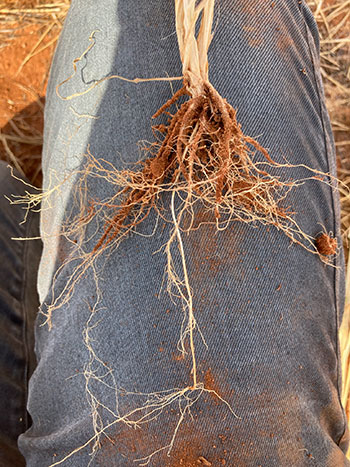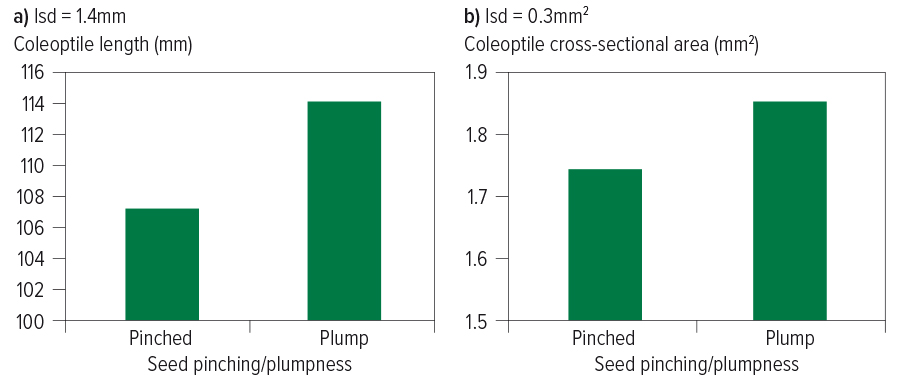Key points
- Changing climate and increasing enterprise size require new plant traits and management systems
- The long coleoptile trait may improve the performance of wheat in these changing circumstances
Adaptive traits to improve rain-fed winter cereals’ water utilisation in the face of increased summer rainfall, less in-crop rainfall – and greater seasonal variability generally – are beginning to emerge from 25 years of research.
At the helm of this traits’ search in recent years at CSIRO Agriculture and Food has been Dr Greg Rebetzke, who says these climatic changes are further compounded by increasing farm sizes that are extending the sowing period.
“These factors are evolving together and driving growers to seek additional tools to maximise crop potential and reduce risk,” he says.
“Earlier sowing, for example, has been facilitated by longer-season standard coleoptile length wheat varieties, but this is usually into dry topsoil. Even though there may be moisture at depth, from summer rain, it is out of reach for these varieties.”
Enter, after exhaustive research, the long coleoptile adaptive trait that equips the plant to reach and use this moisture.
It looks to be a new early sowing crop development breakthrough, but still no silver bullet. “As with any new ‘tool’ we need to weigh up the opportunity with the risks and returns, working with growers to understand how exactly to deploy the tool to achieve a benefit,” Dr Rebetzke says.
Hunt for genes
The coleoptile is a modified leaf which protects the developing shoot as it emerges. A longer coleoptile enables seed to be sown deeper.
“Although the green revolution of the 1960s provided a transformative step forward for crop production, combining reduced height with improved fertiliser use, it was not without its drawbacks,”
 Root growth of a long-coleoptile wheat sown at 120 to 130mm depth. Extensive root system and the very long sub-crown internode places the crown near the soil surface. Extensive crown and nodal root growth has ensured foraging of nutrients while the seminal roots from the seed show opportunity for deep water and nutrient uptake. Photo: Sarah Rich, CSIRO
Root growth of a long-coleoptile wheat sown at 120 to 130mm depth. Extensive root system and the very long sub-crown internode places the crown near the soil surface. Extensive crown and nodal root growth has ensured foraging of nutrients while the seminal roots from the seed show opportunity for deep water and nutrient uptake. Photo: Sarah Rich, CSIRO
He says the green revolution dwarfing genes, used widely in Australian wheat varieties, have been a “handbrake” constraining coleoptile and early leaf area development, and why there has been an intensive search for alternative dwarfing genes for long coleoptiles.
Much of the work has focused on identifying and sourcing new genes from across the world and then assessing them in Australia under both laboratory and field conditions. These genes have been assessed for early growth and agronomic performance, and their biology is now well understood.
“We have assessed over 20 genes and are now working with three to four with the greatest potential for deep-sowing or sowing into warmer soils early in the season,” Dr Rebetzke says.
“These new genes have been tagged with molecular markers developed at CSIRO and we are now working with breeding companies exploring their role in further increasing coleoptile length to improve establishment when deep-sown.”
“Australian breeding companies are also on the hunt for novel coleoptile genetics.”
“These genes and technology packages are now being used by Australian breeding companies to incorporate the long coleoptile trait into new wheat varieties which will be ground-truthed in the field to develop agronomic packages.”
“It is estimated that varieties with these long coleoptile genes are three to five years away from being available for growers.”
Risks
However, Dr Rebetzke points out that just because long coleoptile wheat varieties allow sowing deep and early, it doesn’t automatically mean you should. It is important to have the trait in an appropriate wheat variety with the right phenology for your environment to ensure flowering occurs in the optimum flowering window.
“Sowing deep delays emergence by five to 10 days, depending on depth. Early growth is reduced and tillering delayed to potentially lower spike number. This might curtail yield but could be compensated for by a small increase in sowing rate. Further research is needed here.”
Further research is also required to determine whether sowing deep will increase the susceptibility of these wheats to root diseases, and also expose them to more nematode damage.
“We also need to determine the effect of soil temperature on coleoptile length. We know that increasing temperature increases coleoptile growth but may reduce cell size and therefore coleoptile length, so this needs ground-truthing.”
Rewards and opportunities
Nonetheless, Dr Rebetzke says it is exciting talking to growers about the opportunities long coleoptile wheat varieties may bring: “Growers are very inventive in how they fit such developments into their systems.”
The ability to deep-sow up to almost 14 centimetres with long coleoptile wheat varieties will mean better use can be made of stored soil moisture. A longer period for root growth will also increase access to deeper moisture and opportunities for exploring increased nutrient uptake.
“Growers could further reduce risk by sowing long coleoptile wheats at two different sowing depths to hedge their bets.”
In addition to earlier sowing, long coleoptiles can provide other system benefits including the potential for controlling herbicide-resistant weeds using knockdown herbicides on earlier emerging weeds ahead of the crop.
Long coleoptile wheat varieties may also play an important role in soil amelioration. This has become a widespread practice, particularly in Western Australia. However, newly ameliorated soils face an erosion risk, so seeding with long coleoptile wheat varieties early and deep should provide critical root growth and ground cover to help protect these soils.
Practical considerations
Several environmental and equipment considerations need to be contended with in adopting long coleoptile wheat varieties.
Selecting plump seed can increase coleoptile length and cross-sectional area by six to seven per cent. This gives the growing coleoptile increased energy and mass to germinate and elongate from depth.

Source: CSIRO
Soil texture, seed-zone water content, temperature, light penetration and crop residue can all influence plant performance. Sowing equipment might need to be modified and some pre-emergent herbicides and seed treatments might also affect coleoptile growth. Their use needs to be factored in when deciding on sowing depth.
More information: Dr Greg Rebetzke, greg.rebetzke@csiro.au, 0429 994 226.

























































